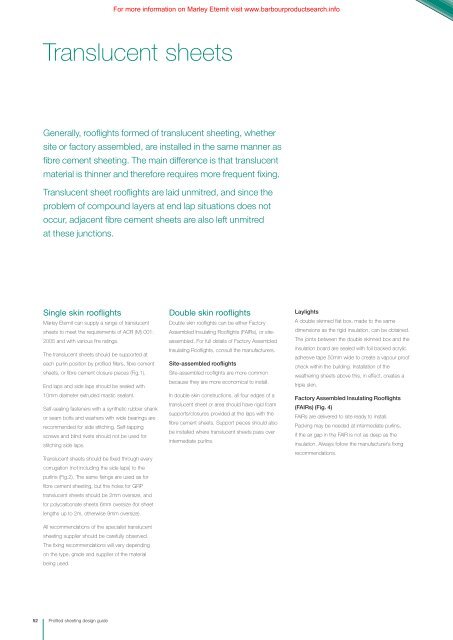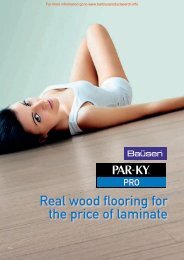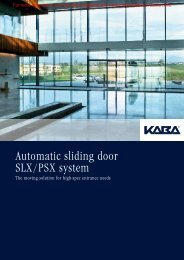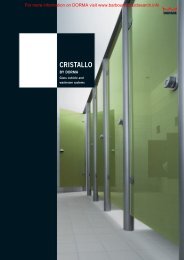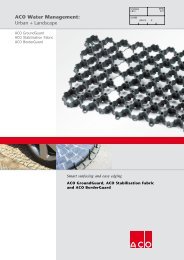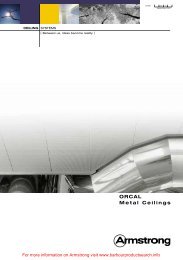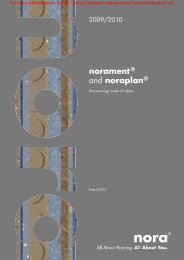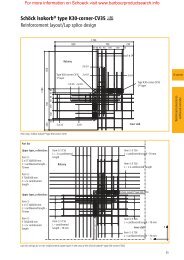Profiled Sheeting Design Guide: Part 3 - Barbour Product Search
Profiled Sheeting Design Guide: Part 3 - Barbour Product Search
Profiled Sheeting Design Guide: Part 3 - Barbour Product Search
You also want an ePaper? Increase the reach of your titles
YUMPU automatically turns print PDFs into web optimized ePapers that Google loves.
For more information on Marley Eternit visit www.barbourproductsearch.info<br />
Translucent sheets<br />
Generally, rooflights formed of translucent sheeting, whether<br />
site or factory assembled, are installed in the same manner as<br />
fibre cement sheeting. The main difference is that translucent<br />
material is thinner and therefore requires more frequent fixing.<br />
Translucent sheet rooflights are laid unmitred, and since the<br />
problem of compound layers at end lap situations does not<br />
occur, adjacent fibre cement sheets are also left unmitred<br />
at these junctions.<br />
Single skin rooflights<br />
Marley Eternit can supply a range of translucent<br />
sheets to meet the requirements of ACR (M) 001:<br />
2005 and with various fire ratings.<br />
The translucent sheets should be supported at<br />
each purlin position by profiled fillers, fibre cement<br />
sheets, or fibre cement closure pieces (Fig.1).<br />
End laps and side laps should be sealed with<br />
10mm diameter extruded mastic sealant.<br />
Self-sealing fasteners with a synthetic rubber shank<br />
or seam bolts and washers with wide bearings are<br />
recommended for side stitching. Self-tapping<br />
screws and blind rivets should not be used for<br />
stitching side laps.<br />
Translucent sheets should be fixed through every<br />
corrugation (not including the side laps) to the<br />
purlins (Fig.2). The same fixings are used as for<br />
fibre cement sheeting, but the holes for GRP<br />
translucent sheets should be 2mm oversize, and<br />
for polycarbonate sheets 6mm oversize (for sheet<br />
lengths up to 2m, otherwise 9mm oversize).<br />
All recommendations of the specialist translucent<br />
sheeting supplier should be carefully observed.<br />
The fixing recommendations will vary depending<br />
on the type, grade and supplier of the material<br />
being used.<br />
Double skin rooflights<br />
Double skin rooflights can be either Factory<br />
Assembled Insulating Rooflights (FAIRs), or siteassembled.<br />
For full details of Factory Assembled<br />
Insulating Rooflights, consult the manufacturers.<br />
Site-assembled rooflights<br />
Site-assembled rooflights are more common<br />
because they are more economical to install.<br />
In double skin constructions, all four edges of a<br />
translucent sheet or area should have rigid foam<br />
supports/closures provided at the laps with the<br />
fibre cement sheets. Support pieces should also<br />
be installed where translucent sheets pass over<br />
intermediate purlins.<br />
Laylights<br />
A double skinned flat box, made to the same<br />
dimensions as the rigid insulation, can be obtained.<br />
The joints between the double skinned box and the<br />
insulation board are sealed with foil backed acrylic<br />
adhesive tape 50mm wide to create a vapour proof<br />
check within the building. Installation of the<br />
weathering sheets above this, in effect, creates a<br />
triple skin.<br />
Factory Assembled Insulating Rooflights<br />
(FAIRs) (Fig. 4)<br />
FAIRs are delivered to site ready to install.<br />
Packing may be needed at intermediate purlins,<br />
if the air gap in the FAIR is not as deep as the<br />
insulation. Always follow the manufacturer’s fixing<br />
recommendations.<br />
52 <strong>Profiled</strong> sheeting design guide


